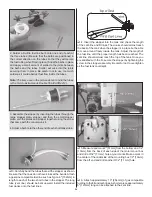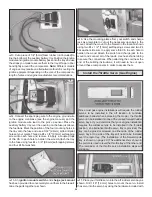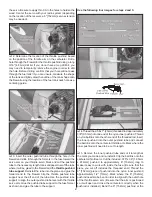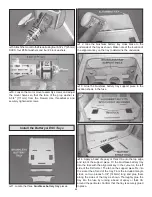
14
❏
3. Temporarily install the wing onto the fuse using two
1/4-20 nylon wing bolts. The wing dowels will fi t into receiving
holes in the former behind the LE of the wing.
❏
4. Test fi t the stab in the fuse. Center the stab left and right
in the fuse. Stand back 15 to 20ft [5m to 6m] and check to be
sure the stab is parallel to the wing. If necessary, adjust the stab
saddle as needed until the stab and wing are parallel.
❏
5. Measure the distance from the tip of each wing to the
tip of the stab. Adjust the stab until the distance from the tip
of the stab to the tip of the wing is equal on both sides.
❏
6. Use a felt-tip marker to mark the outline of the fuse onto
the top and bottom of the stab.
❏
7. Remove the stab from the fuse and cut the covering just
inside the lines you drew. If using a hobby knife to remove
the covering, use care to cut only in the covering and not
into the wood.
❏
8. Use 30-minute epoxy to glue the stab into the fuse by
coating the top and bottom of the stab in the area where you
removed the covering. Slide the stab into position. Confi rm
that the stab is centered as was done in steps 4 and 5. Wipe
away any excess epoxy with a paper towel and denatured
alcohol. Do not disturb the model until the epoxy has fully
hardened. With the stab secure, you can now remove the
wing from the plane.
❏
9. As you did with the ailerons, use a toothpick or wood
scrap to apply epoxy to the inside of each elevator and stab
hinge point pocket. Apply a light coat of epoxy to one end
of all the hinges for the elevators along with a small amount
of petroleum jelly at the center of each hinge. Insert the
hinge points into the pockets, wiping away excess epoxy
with denatured alcohol as necessary. Be sure the hinges
are inserted in the correct orientation. Apply epoxy to the
other ends of the hinges and slide the elevators into place.
Use masking tape to hold the elevators in position while the
epoxy cures.
Содержание GPMA1412
Страница 52: ......















































